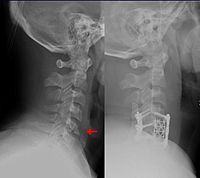
Photo from wikipedia
Short term mentorship research engagements can yield significant academic productivity for promising young investigators. INTRODUCTION The Eastern Association for the Surgery of Trauma mission includes fostering research and providing career… Click to show full abstract
Short term mentorship research engagements can yield significant academic productivity for promising young investigators. INTRODUCTION The Eastern Association for the Surgery of Trauma mission includes fostering research and providing career development opportunities. Eastern Association for the Surgery of Trauma has awarded for 20 years a research scholarship to a promising young investigator. The research mentorship efforts were expanded 5 years ago with the INVEST-C Hack-a-thon. INVEST-C provides an intensive, short-term engagement to propel junior faculty toward establishing research independence. This study investigates the impact of these programs on academic productivity. METHODS Pubmed records, National Institutes of Health (NIH) Reporter data, and SCOPUS h-index were acquired for all scholarship (SCH) awardees from 2002 to 2021 (n = 20) and all INVEST-C (INV) participants (2017–2020, n = 19). Current type of practice, total number of funding awards, and timing of first award were ascertained. INVEST-C participants were also surveyed on an annual basis to track their progress. Medians (interquartile range [IQR]) are reported and compared (analysis of variance). RESULTS Median publications (PUBs) of SCH awardees were 56 (IQR, 33–88), h-index was 16 (IQR, 12–21), and 25% of awardees have ≥1 NIH grant since their SCH. Among the last 10 awardees with a minimum of 2 years from SCH, 40% have received an NIH award compared with a mean NIH funding rate of 18.5% over the same period. For those remaining in academics (90% SCH), PUBs were higher for those >5 years (66 [IQR, 51–115]) versus <5 years from their SCH (33 [22–59]; p = 0.05), but there was no difference in h-index (16 [IQR, 14–25] vs. 15 [9–19], p = NS). Comparing the most recent 5 years of SCH to INV group, there was no difference in academic productivity as measured by total PUBs (SCH, 33 [IQR, 22–59] vs. INV, 34 [IQR, 18–44]; p = 0.7) or h-index (INV, 9 [IQR, 5–14]; p = 0.1). However, no attendee held research funding before INV, but 31.6% (6 of 19 attendees) have subsequently acquired ≥1 funding award (11 non-NIH, 1 NIH) in the short interval since participation. CONCLUSION Investments in research activities have translated to significant extramural funding. Those in the last 5 years have been particularly fruitful with INV participants already achieving equal median academic productivity to SCH recipients. LEVEL OF EVIDENCE Prognostic and Epidemiologic; Level III.
Journal Title: Journal of Trauma and Acute Care Surgery
Year Published: 2022
Link to full text (if available)
Share on Social Media: Sign Up to like & get
recommendations!